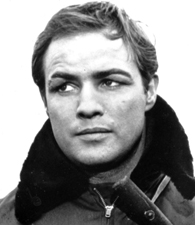Arguably the greatest actor of his generation, Marlon Brando combined his talent for subtle emoting with a rejection of the traditional methods of approaching a role.
Marlon Brando’s Early Days
Marlon Brando Jr. was born on April 3, 1924, in Omaha, Nebraska. Brando’s mother, Dorothy, had wanted to go on the stage; her alcoholism destroyed that dream and contributed to her neglect as a parent. Marlon Sr., a salesman, also abused the bottle and offered little affection to Brando and his siblings. According to The New York Times, “The young boy expressing his anger against his father was seen by Mr. Brando and many critics as the wellspring for many of his performances.”
His parents separated in 1935 and Brando moved to Orange County, California, with his mother and two older sisters, Florence and Jocelyn; two years later, Dorothy and her children reunited with Marlon Sr. in the suburbs of Chicago. After a brief stint at a Minnesota military academy (from which he was expelled), Brando followed the path of his sisters and headed to New York to find work as an actor.
Sources in this Story
- The New York Times: Marlon Brando, Oscar-Winning Actor, Is Dead At 80
- Britannica Online Encyclopedia: Marlon Brando, Jr.
- The Guardian: Great interviews of the 20th century: Marlon Brando interviewed by Truman Capote
- The Atlantic: Marlon Brando: An American Hero
- Time: The Private World of Marlon Brando
Notable Accomplishments
While studying with Stella Adler at the Dramatic Workshop, Brando took on his first stage roles. These performances were rooted in the tenets of Stanislavskian practice, which stresses the importance of human observation, self-recognition, and emotional memory.
Director Elia Kazan gave Brando his breakout role, casting him as Stanley Kowalski in Tennessee Williams’s “A Streetcar Named Desire” (1947). This highly successful production was adapted for the screen in 1951, accelerating Brando’s rise to stardom.
His subsequent film performances—“Viva Zapata!” (1952); “The Wild One” (1953) and “On the Waterfront” (1954)—were major critical achievements. However, the string of successes only masked the demons within.
In an infamous 1957 interview with Truman Capote Brando rambles on about acting and philosophy with self-absorbed incoherence. “His eyes had changed,” writes Capote. “Now he looked at people with assurance, and with what can only be called a pitying expression, as though he dwelt in spheres of enlightenment where they, to his regret, did not.”
Film critic Pauline Kael tried to make sense of Capote’s “venomous” portrayal in her 1966 essay “Marlon Brando: An American Hero.”
“The unwary Brando was made to look public ass number one…When you’re larger than life you can’t just be brought down to normalcy.” She blamed the industry for not knowing what to do with Brando’s considerable talents and turning him into a “comic” figure.
The Man and His Work
- “A Streetcar Named Desire”
- “On the Waterfront”
- “The Godfather: The Coppola Restoration”
- “The Wild One”
- “Apocalypse Now: The Complete Dossier”
The Rest of the Story
Regardless of whether one buys into Capote’s vacuous, disillusioned celebrity or Kael’s depiction of a brilliant actor suffering from systematic overexposure, the fact remains that the quality and success of Brando’s work trailed off throughout the 60s.
It wasn’t until 1972 that he managed to recapture critical acclaim with “The Godfather” and “Last Tango in Paris.” Brando had no intention of currying favor, though; he chose not to accept his Oscar for Best Actor for his role as Don Vito Corleone in “The Godfather” to protest the treatment of Native Americans in Hollywood.
Though Brando continued to work sporadically for the next three decades, his efforts were usually overshadowed by snide comments about his weight and tabloid headlines. People magazine reported in 1995 that he had fathered 11 children with three wives and four other women.
A 1976 interview with Time magazine prior to the filming of “Apocalypse Now” captures the discontent of his later years: “I notice,” [Brando] says, “that the width of a Hollywood smile in my direction is commensurate with how my last picture grossed.”
He died in 2004 of pulmonary fibrosis at the age of 80.
This article was originally written by Devin Felter; it was updated March 1, 2017.











